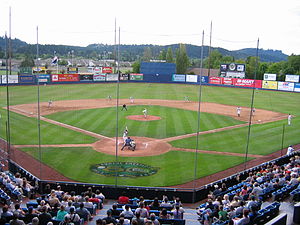- Civic Stadium (Eugene)
-
Civic Stadium 
Civic Stadium in July 2004Location 2077 Willamette Street,
Eugene, Oregon 97405
 United States
United StatesCoordinates 44°02′12″N 123°05′27″W / 44.03667°N 123.09083°WCoordinates: 44°02′12″N 123°05′27″W / 44.03667°N 123.09083°W Opened October 28, 1938 Owner Eugene School District Surface Natural grass Construction cost $18,000 Architect Works Progress Administration Capacity 6,800 Tenants South Eugene High School
Eugene Emeralds
Northwest League (A) - (1974-2009)
Pacific Coast League (AAA) - (1969-1973)Civic Stadium is an outdoor athletic stadium in Eugene, Oregon, owned by the Eugene School District.
Contents
History
Originally built for high school football and baseball in 1938, it became the home of the Eugene Emeralds minor league baseball team in 1969, who previously played at Bethel Park. The Emeralds moved up to the Pacific Coast League (AAA) in 1969 for five seasons, then returned to the Class A Northwest League in 1974, and played in the stadium through 2009.[1] (High school football moved to the University of Oregon's Autzen Stadium in 1969, following the installation of artificial turf.) Prior to the departure of the Emeralds in 2009, Civic Stadium was one of the ten oldest minor league baseball facilities in the United States. The stadium has a seating capacity of 6,800 and is located near East 20th Avenue and Willamette Street;[2] adjacent to South Eugene High School, whose varsity baseball team uses the stadium for its home field.[3]
Civic Stadium was built in 1938 through a public-private partnership between the Eugene Area Chamber of Commerce, Eugene School District 4J and the federal Works Progress Administration.[4] In October 2008 at the age of 70, Civic Stadium was added to the National Register of Historic Places.[5]
The lighted playing field at Civic Stadium is oriented in an unorthodox configuration, with the batter and catcher facing southeast, resulting in difficult visual conditions for the fielders on the left side of the diamond for games played near sunset. (The recommended orientation of a baseball diamond is east-northeast.)[6]
Emeralds' decision to relocate
In August 2009, the Emeralds announced their relocation to UO's year-old PK Park for the 2010 season. The Emeralds cited Civic Stadium's need of substantial renovations, major problems with irrigation and electrical systems, as well as broken seats, and estimated that modernization could cost as much as $15 million.[7] The Emeralds played their last game at Civic Stadium on Thursday, September 4, 2009, a 5-3 loss to the Salem-Keizer Volcanoes. Following the game, fans collected pieces of the outfield turf as souvenirs.[8]
Future uses
The school district has designated it a surplus property, although the district has not made a decision on whether to sell the facility.[9] As recently as 2007, the school district examined options to redevelop all or part of the stadium property, most likely as medium-density residential units.[10] A local community group, Save Civic Stadium, has begun a grassroots community campaign in support of restoring the historic stadium, while also attempting to locate alternative tenants for the facility.[11]
With the future of the stadium in flux, it is one of ten entries on the Historic Preservation League of Oregon's Most Endangered Places in Oregon 2011 list.[12]
References
- ^ Minor League Baseball.com - Eugene Emeralds - history - accessed 2011-07-23
- ^ Smith, Jeff (2009-06-19). "Eugene Emeralds say hello -- and prepare to say goodbye -- to Civic Stadium". OregonLive.com (The Oregonian). http://www.oregonlive.com/sports/index.ssf/2009/06/eugene_emeralds_say_hello_and.html. Retrieved 2009-09-05.
- ^ "Facilities". South Eugene Athletics.com. South Eugene High School. http://www.southeugeneathletics.com/facilities.htm. Retrieved 2009-09-05.
- ^ Eugene Modernism 1935-65: Education. June, 2003
- ^ "Eugene Civic Stadium listed in National Register of Historic Places". Oregon Parks and Recreation Department. http://www.prd.state.or.us/news.php?id=1153.
- ^ MLB.com - playing field orientation - rule 1.04 - accessed 2011-07-23
- ^ Hill, Benjamin (2009-08-25). "Emeralds pick PK for new home". MiLB.com (Minor League Baseball). http://eugene.emeralds.milb.com/news/article.jsp?ymd=20090825&content_id=6610654&vkey=news_milb&fext=.jsp. Retrieved 2009-09-05.
- ^ Morrison, Dan (2009-09-04). "Ems play final game at Civic Stadium". KVAL. http://www.kval.com/news/local/57318612.html. Retrieved 2009-09-05.
- ^ LeBeau, Arrianee (2009-09-02). "What does the future hold for Civic Stadium?". KVAL. http://www.kval.com/news/local/56839787.html. Retrieved 2009-09-05.
- ^ Board of Directors Meeting Minutes, School District 4J, Lane County, 2007-12-12, http://www.4j.lane.edu/files/board/reports/4J_BOD_report_2007-12-12.pdf, retrieved 2009-09-04
- ^ "Save Civic Stadium". http://www.savecivicstadium.org.
- ^ "Most Endangered Places 2011 - Civic Stadium". Historic Preservation League of Oregon. 2011. http://www.historicpreservationleague.org/mep_CivicStadium.php. Retrieved 5 June 2011.
External links
- Save Civic Stadium.org - History of Civic Stadium
U.S. National Register of Historic Places Topics Lists by states Alabama • Alaska • Arizona • Arkansas • California • Colorado • Connecticut • Delaware • Florida • Georgia • Hawaii • Idaho • Illinois • Indiana • Iowa • Kansas • Kentucky • Louisiana • Maine • Maryland • Massachusetts • Michigan • Minnesota • Mississippi • Missouri • Montana • Nebraska • Nevada • New Hampshire • New Jersey • New Mexico • New York • North Carolina • North Dakota • Ohio • Oklahoma • Oregon • Pennsylvania • Rhode Island • South Carolina • South Dakota • Tennessee • Texas • Utah • Vermont • Virginia • Washington • West Virginia • Wisconsin • WyomingLists by territories Lists by associated states Other  Category:National Register of Historic Places •
Category:National Register of Historic Places •  Portal:National Register of Historic PlacesCategories:
Portal:National Register of Historic PlacesCategories:- Sports venues in Eugene, Oregon
- Soccer venues in Oregon
- Works Progress Administration in Oregon
- 1938 establishments
- National Register of Historic Places in Eugene, Oregon
Wikimedia Foundation. 2010.
